1968 South African Grand Prix race report: Familiar feeling for Lotus
Lotus takes a 1-2 with Jim Clark leading home Graham Hill, the Scot carrying on his winning form from the end of last season
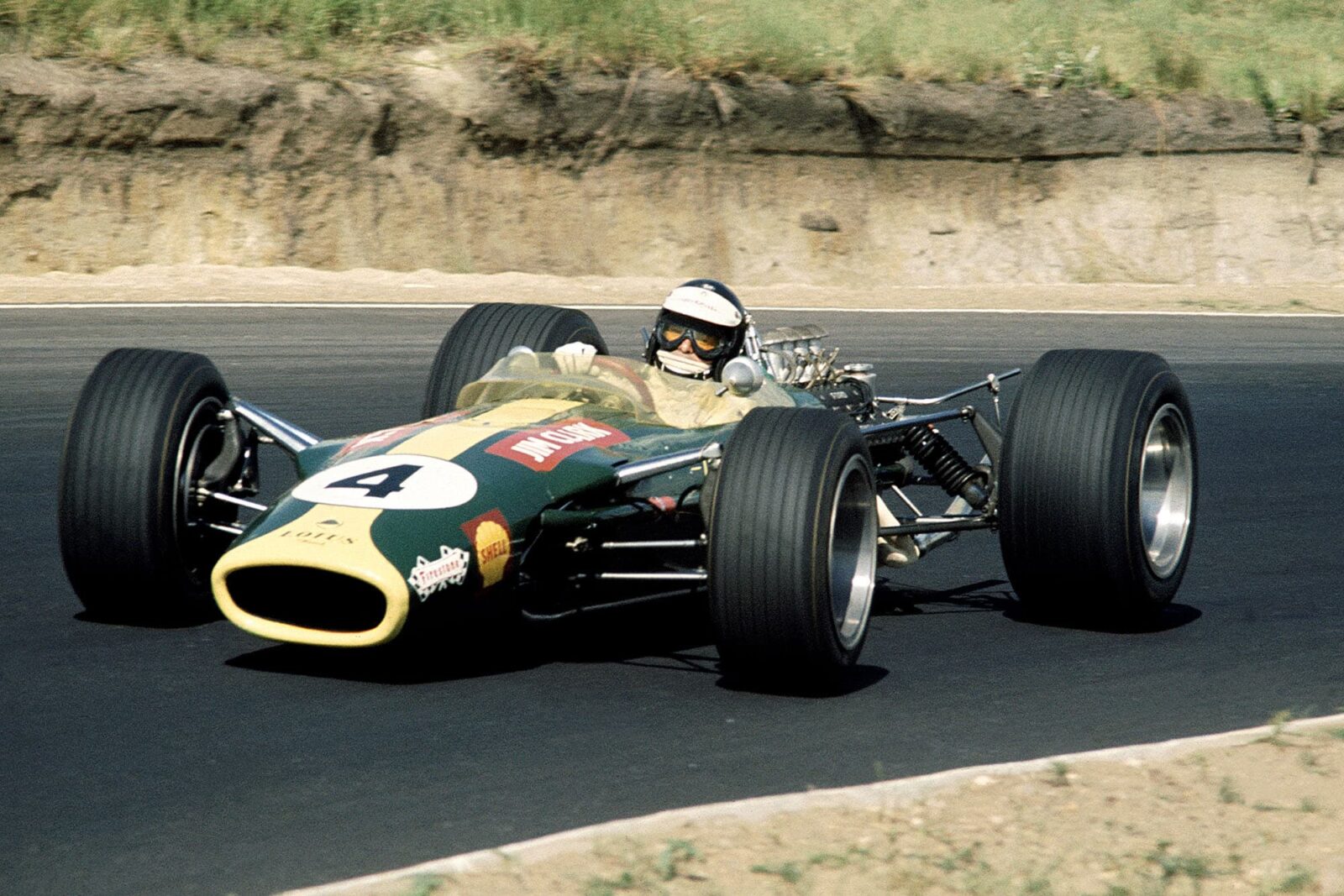
Jim Clark won the season opener for Lotus
Motorsport Images
The first race of the 1968 season was run at the 4.1km Kyalami circuit just outside Johannesburg. This year the Grand Prix of South Africa had drawn all the Formula One teams and all the top drivers except McLaren, who was working on the two new McLaren-Cosworth V8s which he and Hulme will use later in the season.
The organisers had spent a lot of money since last year widening the track and re-surfacing the whole 2½ miles. In addition, many of the internal service roads had been re-surfaced; the whole set-up taking on an atmosphere of growing permanency and prosperity.
BRM had brought three cars, the slim, lighter H16 for Spence; this was unaltered since Mexico except for the removal of Stewart’s tartan seat. For Rodriguez, who is joining BRM for 1968, there was the new Len Terry-designed V12 car. This follows usual F1 design, having a monocoque that extends back under the V12 engine, which is the same as had been fitted to the McLaren for the end of last season’s races.
However, whereas the engine in the McLaren was only developing about 365bhp the developed version the works car was using develops nearly 400bhp. The weight of this new car is only just over the 500kg limit, which should make it competitive. The third BRM was the supercharged 1½-litre V16 which was to give a demonstration in the hands of Graham Hill.
The only other all-new car was the Matra-Cosworth V8 entered by Matra International and driven by Stewart. Under the management of Ken Tyrrell the car had been rushed through and was so new that it hadn’t even been painted, appearing in natural green glass-fibre finish. The rigid F2 monocoque construction finishes just behind the driver. The Cosworth V8 engine is attached to the monocoque by plates from the cylinder heads and two mountings at the bottom.
Unlike Lotus, who use the engine for structural support to the suspension, Matra have a detachable tubular frame which connects to a fabricated cradle in which the back of the engine and the Hewland gearbox sit. The rear suspension is fixed to this cradle and is of current F1 design, as is the front end. The radiator and oil tank are up ahead of the monocoque but the oil radiator is bolted to the top of the frame behind the driver’s head. This entry brings Dunlop back into F1 racing after being missing for much of last season. As a spare there was a brand new F2 Matra, a replacement for the one Stewart wrote off at the Spanish Grand Prix. As neither of these cars had previously run, much of practice was spent setting them up properly.
Ferrari were appearing at Kyalami for the first time. Last year there was starting money trouble but they made up for this in 1968 with a team of three cars for Amon, Ickx and de Adamich. The cars were all 1967 type, although the engine now gives 408 bhp at 11,000rpm.
Team Lotus had two cars, for Hill and Clark. Hill’s car was the one he has used for most of last season, while Clark’s was a brand new chassis, 49/4. Although marked on the chassis plate as a 49-series Mk II it was, in fact, to Mk I specification, as last year.
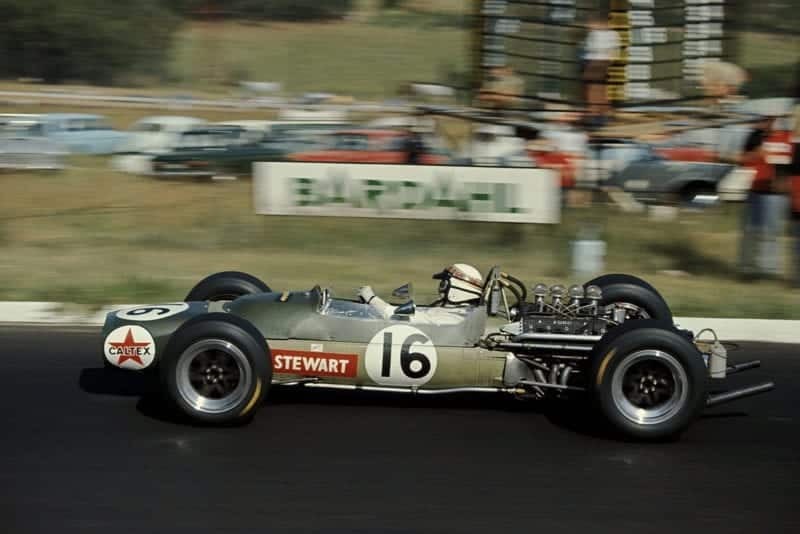
Stewart was racing a Matra for the first time
Motorsport Images
The Brabham team had their usual two cars and their new driver, Rindt. Brabham, who was not entered originally, turned up to drive his usual car, which was fastest in practice last year. Cooper had been expected to turn up with their new Cooper-BRM V12 but although one car is finished it had not done any testing, so John Cooper, who is now managing the team in place of Salvadori, decided to bring the two Maserati-engined cars for a last outing. Coopers have had some driver difficulties and although Scarfiotti was to drive one car, the other driver was not known until practice started, when Brian Redman went out.
As the new McLaren-Cosworth won’t be ready for about another month, Hulme was to drive the McLaren-BRM V12 which the team has been racing since the Canadian Grand Prix. This first race for the 1967 World Champion in his new team could not be very competitive as no further development had taken place since the new 1968 cars were started on. The only difference in the McLaren is its change of colour; it is now orange, as were the successful Can-Am cars.
Gurney had one Eagle-Weslake V12 for himself, this again being as raced at the latter part of the season. New exhausts were fitted, with megaphone ends and a restricting throat where the six pipes from each side merge into two.
Surtees’ Honda was unchanged since Mexico although the fuel system seemed to work better without quite so much fluffing. Matra Sport had entered an F2 Matra-Cosworth FVA for Beltoise to drive, adding to his and the team’s experience in time for the V12 Formula One car which is supposed to run at the Spanish Grand Prix in April.
This completed the teams; the other eight entries were private owners. Siffert and Bonnier both had the same Cooper-Maseratis they used all last season. John Love, who very nearly won last year’s South African Grand Prix, was entered to drive a 1966 Brabham-Repco V8 by Team Gunston. Also under their colours was Sam Tingle, in an LDS-Repco V8.
Dave Charlton, who is having a very successful S African season, was driving a 1964 Brabham with Repco V8, and is the fastest of the South African/Rhodesian drivers. Jackie Pretorius in a Brabham-Climax 4-cyl and Basil van Rooyen in Love’s Cooper-Climax 4-cyl made up the last of the runners. One other entry, a Cooper-Climax for Tony Jefferies, was a non-starter.
Qualifying

Surtees was driving the same spec Honda as in the previous season
Motorsport Images
The first practice was on Thursday afternoon and this suffered from a not unusual breakdown on the BOAC service. Many mechanics and tyre technicians were bleary-eyed when the Boxing night flight was 14 hours late after changing three aircraft, and the next night’s flight was 11 hours late, with many of the drivers on it. However, those who did turn up were soon out on the new wider surface, with last year’s time of 1min 29.9sec (1min 28.3sec practice) to beat.
De Adamich, Surtees and Clark were first off and in four laps Clark showed what he would do with last year’s record. His four flying laps were: 1min 37.1sec, 1min 31.6sec, 1min 30.0sec, 1min 27.6sec. Although he did the greatest number of laps, each time he went out another second or part of a second was knocked off until just before practice closed he had set a time of 1min 23.9sec (176.083kph).
The two Brabhams did a few laps; with Brabham the faster of the two while Rindt was getting the feel of the car. Neither started out until the last half-hour when it was overcast from the edge of one of the thunderstorms hovering round about, but even in these coolish conditions, both cars were running, at high temperatures.
Hulme did even fewer laps than the Brabhams and the McLaren-BRM showed signs of fuel vaporisation even at this stage. Surtees got the Honda going well and did 1min 26.4sec, which indicated that he might go quite well. De Adamich did his fast lap on the second flying lap and after that the high temperature of the fuel slowed him down.
The BRM V12 which was to be driven by Rodriguez was being set up by Spence but appeared to be lacking in power for it couldn’t get down to the time of the less powerful McLaren-BRM V12. The Coopers were both slow and boiling and couldn’t get down to the times done by Rhodesians Love and Tingle.
Stewart got back into his stride again when he felt he was back into a really competitive car again. His practice session was taken up mainly by getting the car set up to handle to his liking, which meant mainly changing it from an understeer to a neutral or even oversteering set-up. From the first outing, when he went to under 1min 30sec, his time improved until in the end he was only 0.8sec slower than Clark’s time, and he was very happy with the car’s first outing. Practice finished with a shower of rain laying the dust.
Next day all cars and drivers were out except for the non-starter, Jefferies. The temperature was much higher and with exception of Clark’s every car was having heat problems. Hulme’s vaporisation slowed the McLaren after a few laps, and plans were being made to move the fuel lines and get air over the fuel pump. Stewart was overheating in the Matra-Cosworth V8, so he took out the F2 car to get this set up and run some of the stiffness out of it.
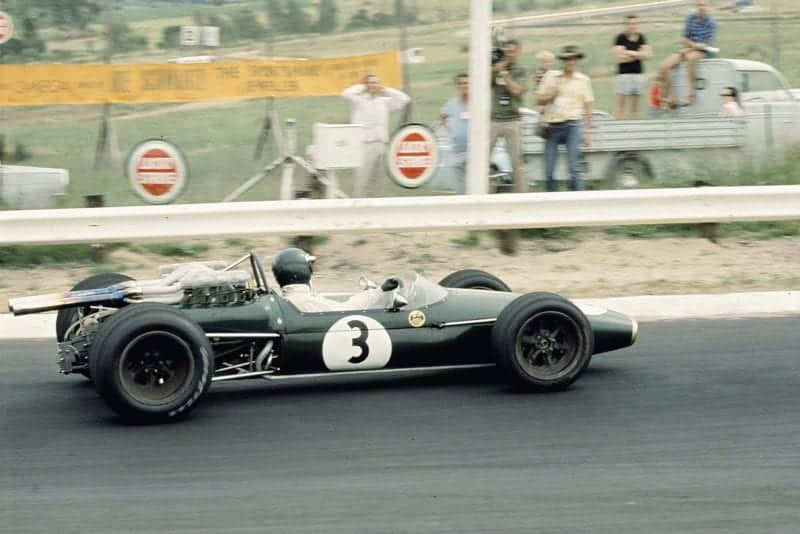
Rindt had switched over to Brabham for ’68 and was setting impressive times in qualifying
Motorsport Images
Brabham and Rindt got down to 1min 24.8sec and 1min 25.2sec, respectively, although the cars were both boiling hard after each run and Brabham’s was spraying out a lot of oil. Gurney had the Eagle down to 1min 25.6sec fairly quickly, then vaporisation caused damage to the fuel pump and so the Eagle never got into its stride.
Surtees again did a lot of short bursts of practice but was unable to better 1min 25.2sec. All the Ferraris were out and put in a lot of laps, with Amon the fastest at the end of the day. lckx was losing a lot of time round the circuit by not driving smoothly and he was finding F2 techniques do not get fast times in a F1 car. All the Ferraris were running at high temperatures after only a few laps. Amon’s metering unit broke just before the end of practice.
BRMs were still not happy. The H16 driven by Spence was predictably slow, but the main disappointment was the fact that the V12 was not going well and seemed to be suffering from fuel starvation, finally stopping out on the circuit. After practice this was diagnosed as a flat battery which was run down due to faulty wiring of the charging unit.
Scarfiotti improved his time in the Cooper-Maserati slightly but Redman stopped on the circuit when he felt the engine stiffen. However, after mechanics examined the car they found it all right and sent him off for two more laps.
Beltoise had the F2 Matra down to 1min 27.5sec and his was one of the few cars not suffering front the heat. The private entrants were all having heat problems and Siffert and Charlton were the fastest, sharing a time of 1min 27.5sec.
While all these heat problems were taxing the ingenuity of the other teams, Lotus were getting on with the job. Hill was not having things as easy as Clark for his car stopped out on the circuit when the fuel pump cut out, then when this was repaired the link from the roll-bar to the left rear upright twice fell off, and, lastly, his clutch was playing up. In spite of these problems his time of 1min 24sec was beaten only by his team mate.
Clark continued to improve his time to 1min 23.0sec, then he asked to try the new Dunlop tyres. These were fitted and in three laps he recorded 1min 22.9sec, complaining of understeer. With 6lb more pressure in the front tyres to get the profile higher (the centre was running cooler than the edges), he went out again and got down into the 22sec immediately, finishing with a time of 1min 22.4sec. The car was still not set up properly for Dunlop tyres and the inner left-hand tread was running at up to 120º C, which, in the old days, would have been fatal, but the new soft compounds are designed to run hot.
The last practice was just a little cooler and most cars had extra cooling aids for this practice. The McLaren had an elaborate form of ducting and shielding which proved unsuccessful, and was removed. Ferrari had an extra water radiator sticking out from the side of the cockpit, but this made little difference.
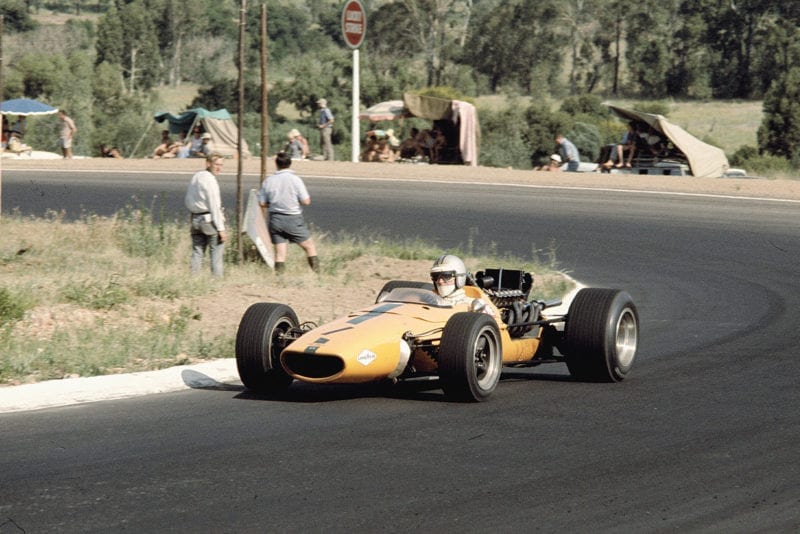
Hulme’s McLaren team were experimenting with different air ducts for cooling
Motorsport Images
Coopers were using a liquid in place of water that looked like a cherry puree, and from the quantities blowing from the breather this was boiling as easily as water. The Matra-Cosworth V8 had the nose cut and opened and another small radiator fitted into the water pipes behind the rear suspension and this worked, bringing down the temperature.
One of the cleverest cooling systems was that on the Brabhams. The external water pipes had been removed and in their place a hollow tubular jacket had been placed, air entering the rube at the front and coming out at the back, and the water was getting extra cooling from the inside and outside of this jacket. As the water was not boiling in the third practice this appeared to be a success.
The Eagle started practice early and after a few laps was on the trailer returning to town because another fuel-pump had failed. Both Brabhams put in a lot of laps in this last period and Rindt got down to 1min 23.0sec when he discovered how far he could slide the Brabham and not lose it. Brabham finished up 0.2sec slower than his new driver.
Clark continued with the Dunlop tyres, the car now adjusted and with wider-rim wheels on the front. His times were consistently in the lower 22sec but his-fastest lap of 1min 21.6sec (181.03kph) was after he had changed back to Firestones using the Dunlop suspension settings. Hill got down to 1min 22.6sec to get second place on the grid.
Third fastest was the Matra-Cosworth V8, only 0.1sec behind Hill, a position which pleased Stewart and Tyrrell very much. However, at the end of practice, they had not made up their minds which car to use for the F2 car was down to 1min 26.2sec and would run the whole race without a fuel stop or heating problems, whereas the prototype F1 car would not have enough fuel capacity to run the full race. The decision they had to make was whether to get a fourth or fifth place and learn nothing with the F2 car, or try the F1 car with its possible retirement or at the least losing places for a fuel stop.
The Honda again improved its time after a lot of laps, as did the Ferraris with de Adamich fastest with 1min 23.6sec, a bare 0.2sec faster than Amon. The New Zealander took out all three cars during the day with his own number on in each case. In lckx’s car he did a time of 1min 23.9sec and in de Adamich’s car he managed 1min 24.6sec BRM were still in trouble, for Rodriguez broke down out on the circuit on two occasions, each time with a burnt-out transistor box; after fitting several boxes it was discovered that the wiring was wrong, and when this was put right Rodriguez managed to get down to 1min 24.9sec, a full second quicker than Spence in the H16.
Both Coopers put up predictable performances with Scarfiotti 2sec quicker than Redman. Charlton’s time of 1min 26.2sec made him easily the fastest of the private owners, and with every car inside last year’s lap record the chequered flag went out for the end of practice.
Race
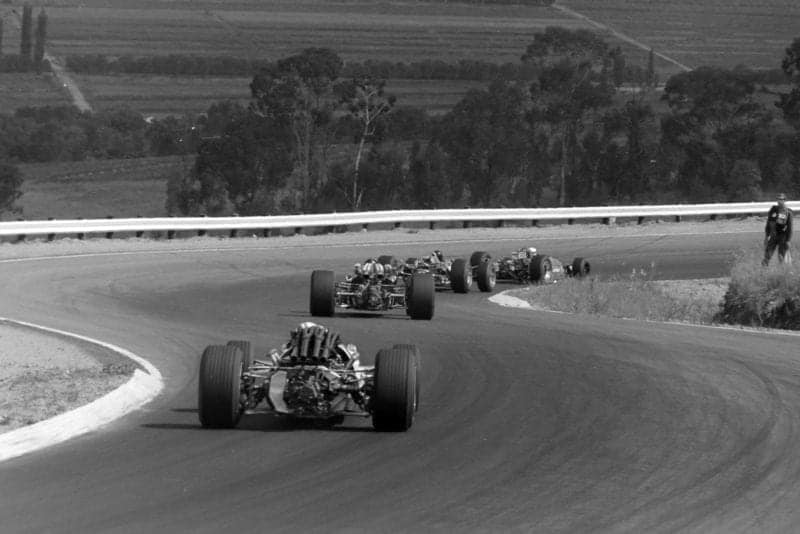
Stewart leads the pack on lap 1
Motorsport Images
With Sunday as a rest day before the race, all the teams had plenty of time for leisurely preparation before the 3pm start on Monday.
Race day dawned clear and sunny, which meant that temperatures were going to rise even higher than in practice. During Sunday a lot of cooling systems had been added to or improved. The Eagle team had not made any cooling additions but their 40-gallon fuel drum was stored in a refrigerator so when it arrived at the circuit it was nearly at freezing point. Also the new exhaust system had been changed for that used at the last races. The complicated McLaren cooling additions had been simplified to four flexible hoses to the metering unit and the fuel pumps.
Ferrari had decided to fit the extra water radiator on all three cars sticking out of the left-hand side. Coopers had changed Redman’s engine for the 36-plug unit which had been a spare. Walker’s car had new piston rings fitted and was using glycol for the coolant. BRM had fitted fuel radiators to each of their two cars, the H16’s, just behind the crash-bar, while the V12’s radiator was over the gearbox. Hill’s Lotus was sitting in the pits unattended while there seemed to be a panic around Clark’s car.
On Sunday the engine had been changed as a liner was suspected of having cracked, and in the morning warm-up an oil leak was discovered, and it was this that was being feverishly worked on. All was screwed together before the drivers made their lap of honour in vintage or near-vintage vehicles. At ten minutes to three, the cars made the warming-up lap and on time they moved from the dummy grid to the proper grid, with the track temperature at well over 130ºF.
As the flag fell, Stewart made a brilliant start, beating the “maestro from the starting line”—Clark—and at the first corner the Matra-Cosworth V8-was well ahead of the Lotus-Cosworth V8.
“As the flag fell, Stewart made a brilliant start, beating the ‘maestro from the starting line’—Clark”
At the end of lap one the order was Stewart, Clark, Rindt, Surtees, Brabham, Amon and then Hill, who had made a very poor start. Next came Gurney, followed by de Adamich, Hulme, Ickx, Spence, Siffert, Rodriguez, Love, Scarfiotti, Redman, Charlton, Bonnier, van Rooyen, Beltoise, Tingle and, last, Pretorius.
Clark was already harrying Stewart and before the next lap was over the Lotus was ahead of the Matra. No-one could keep up with Clark and he began opening the gap at about a second a lap. Hill moved up two places, passing Gurney and Amon and fixing himself in Brabham’s slipstream.
* * *
Ickx slipped by Hulme on the second lap and stayed there. Charlton made meteoric progress from 18th place to 13th and then back to last place when he came into the pits with suspected gear trouble.
On the next lap, Charlton retired with a stripped crown-wheel. Rodriguez made an erratic start, dropping five places on the second lap, regaining three of them in the next two laps and losing them again two laps later.
Scarfiotti was the first retirement; he stopped out on the circuit on lap 2 when a water pipe broke, and as he leapt from the car he stripped off his overalls with badly scalded legs. An ambulance and helicopter transported him to hospital with first degree burns. With one Cooper gone, the other was in the pits on the fourth lap with overheating and, on the next lap, Redman retired.
De Adamich had been close behind Gurney for the first few laps and Ferrari’s new boy went ahead on lap 5. The Eagle was not going at all well and by lap 12 it was passed by Ickx’s Ferrari and the McLaren-BRM V12.
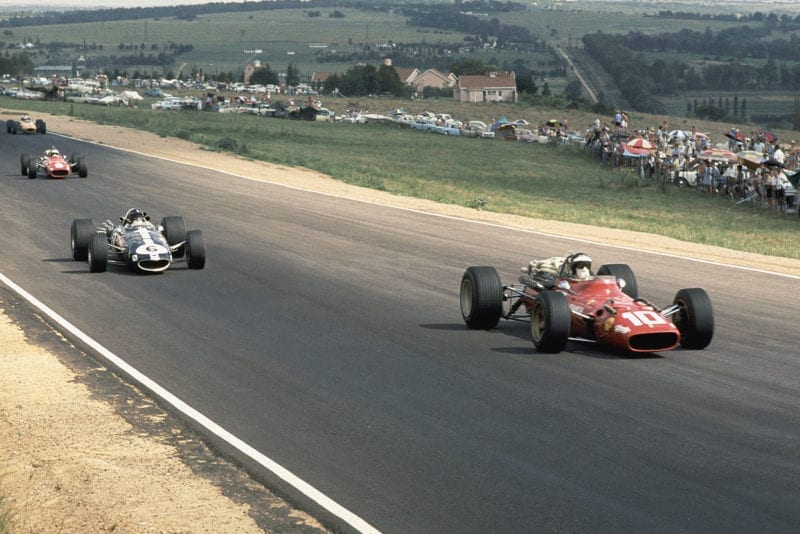
De Adamich passed Gurney on lap 5
Motorsport Images
Bonnier made surprising progress in the opening laps, moving from 19th place on laps 1 and 2 to 13th by laps 7 and 8. However, the Swede was at the back of the bunch of four cars he was mixing it with in two further laps, when van Rooyen, Beltoise and Love repassed him.
On lap 8 Spence brought the hot and smoking H16 BRM to the pits and retired with fuel vaporising. Brabham passed his new teammate on lap 7 but not for long, for the Repco engine went sick, not allowing more than 7,000revs, and two laps later Rindt and Hill went by into third and fourth places.
By lap 10 Clark had a 7.5sec lead over Stewart, who was 4.1sec ahead of Rindt, who, in turn, was 1.1sec clear of Hill, with Brabham a few cars’ lengths further down. Hill pressed Rindt and on lap 13 the Lotus went by into third place behind Stewart’s Matra.
Just before Hill passed Rindt someone spread a swath of oil around the circuit and as the cars scrabbled round the Clubhouse left-hander they were all over the road. De Adamich, whose experience with Formula One is still very limited, came, understeering, towards the outside bank, gave a squirt of power to bring the back round, but didn’t estimate this correction properly and spun violently, hitting the inside safety barrier a short way down the straight. Although causing no personal damage, the car was badly bent and was out of the race.
The V12 BRM made the first of several pit stops with boiling fuel problems which culminated in Rodriguez’s retirement on lap 20. Brabham made one long pit stop, then continued slowly, retiring on lap 17 with a suspected broken valve.
“Someone spread a swath of oil around the circuit and as the cars scrabbled round the left-hander they were all over the road”
On lap 20, the field was depleted to 16 cars. Clark, Stewart, Hill and Rindt still led, separated by 15.7sec, 4.2sec, and 3.8sec, while Amon was 14.6sec further back in filth place and finding the Ferrari a handful to keep on the track.
Gurney’s engine seemed to pick up a bit and he re-passed Hulme for some laps but the reigning World Champion kept close behind. Van Rooyen, who drove in a very competent way, reaching 12th place at one time, retired on lap 22, with engine trouble.
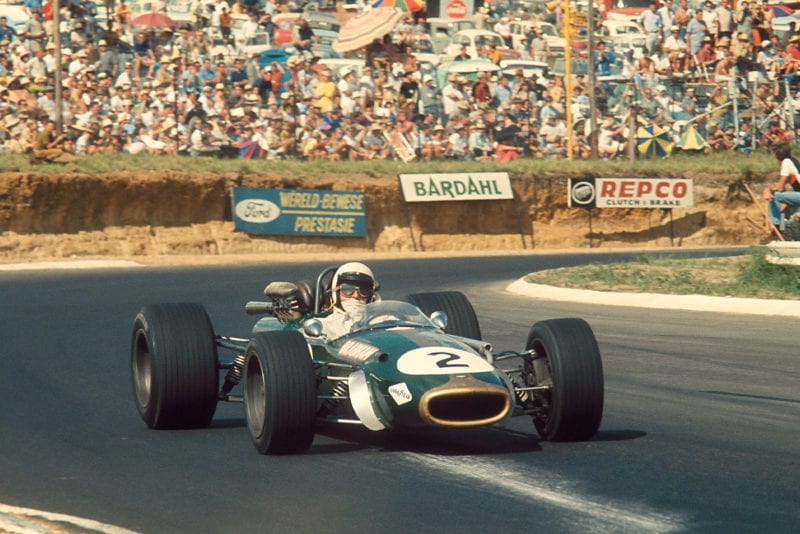
Brabham retired on lap 17
Motorsport Images
Tingle was slowing down and starting from lap 18 he made seven pit stops with overheating ignition and fuel, which finally caused his retirement on lap 35. Surtees was lying sixth on lap 23 with Ickx right up his exhaust, and on lap 24 the Ferrari got by the Honda, which put him in the way of Gurney and Hulme.
These two were still in very close company and Hulme managed to pass Gurney on lap 27, and both of them went by Surtees when his goggles disintegrated, which necessitated a rapid pit stop. In days gone by the spare goggles worn round the neck would have been used but today no drivers wear spares.
On the 30th lap, Gurney re-passed Hulme into seventh place, while in the lead Clark now had 17sec over Hill, who three laps previously had managed to get by Stewart. The Matra held Hill on all the slower corners, but on the fast curves, understeer was slowing Stewart and it was here that the Lotus with its longer development had the edge, and went by into second place. On lap 30 Stewart was still only 0.6sec behind and was grimly hanging on.
Gurney made a very quick pit stop on lap 33, which let Hulme get away from him, but the Eagle only lost the one place. Siffert, lying 10th, went up one place when Surtees went into the pits to see if his injection could be adjusted as the engine was dying at anything under 9,000 revs., which was making the slow corners somewhat tricky. After the pit stop, which dropped the Honda behind Bonnier, Surtees made short work of catching him and the Honda was in 12th place on the 40th lap.
Clark’s lead was now 23sec over Hill and Stewart had dropped back by 2sec, with Rindt 13.3sec behind. The race had now settled down, with half the laps gone and only 14 cars left. Of these, a scrap was developing between Beltoise in the F2 Matra and Siffert’s Cooper-Maserati.
On lap 40 the gap was 6sec but in 10 laps’ time the blue French car was 0.2sec behind and trying to get by. In these 10 laps the only challenge to the Lotus-Cosworth supremacy was removed when Stewart’s Matra-Cosworth broke a connecting rod which in turn punched a hole in the side of the engine. This let Rindt into an unassailable third place, followed by Amon, Ickx, Hulme, Gurney, Siffert, Beltoise, Love, Surtees, Bonnier and Pretorius; the latter many laps behind.
Bonnier was the next to fall by the wayside when he lost a rear wheel on the circuit. He collected the hub cap and had some officials to help him to lift the car to re-fit it. However, he retired just afterwards with overheating.
On the 51st lap, Ickx’s race was run and he stopped out on the circuit, when an oil pipe broke, spraying the rear wheels with oil, which gave him quite a moment.
Before the 60th lap, Gurney came into the pits to ask where he was and whether it was worth going on as his oil level was getting very low. The Weslake engine kept going for two more laps before the oil situation got critical and it was retired before causing too much damage.
“Ickx stopped out on the circuit, when an oil pipe broke, spraying the rear wheels with oil, which gave him quite a moment”
With Gurney’s retirement the closely contested places were sixth and seventh, where Siffert was just holding Beltoise. The Formula Two car’s persistence and the fact that the heat was not affecting it, won through and Beltoise got by into sixth place. Before the end he had pulled out a 12.2sec, lead.
In the closing laps, Rindt began to catch Hill and ten laps from the end he was 9.3sec behind. The gap between Clark and Hill remained the same, about 25sec, and with the fuel now low, Clark’s lighter car put in the fastest time, on lap 73, in 1min 23.7sec (176.5kph).
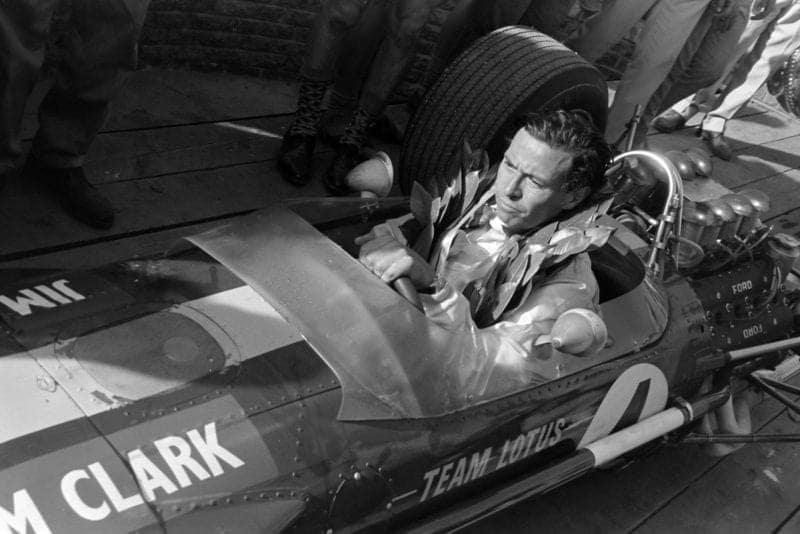
Clark sports the winner’s wreath
Motorsport Images
Except for Amon making a last-minute pit stop for fuel, when he did not lose a place (evaporation made the Ferrari use 54 gallons as against the 30 it should have used), this was the end of a very tricky race. Clark and Hill first and second, put Lotus and Cosworth right on top at the beginning of what should be an exciting season.
“Clark put Lotus and Cosworth right on top at the beginning of what should be an exciting season”
The built-in fuel-cooling system where the fuel circulates from the metering unit overflow through the inlet manifolds to the small pick-up tank paid off 100% at this race, for neither Lotus had any vaporisation problems. Also the large radiators kept the water within the bounds of the pressure caps.
Third came Rindt, very happy with his first drive in a Brabham-Repco V8. A lap behind was Amon’s Ferrari, just 13.4sec ahead of Hulme’s McLaren-BRM V12. Then, another lap down, came Beltoise and Siffert. The only other qualifiers were Surtees and Love on the 75th lap.
Running at the end but not qualifying was Pretorius, who completed 70 laps. Too many cars retired again this year with heat problems; surely when the 1969 race takes place some more teams will remember this year’s conditions!
